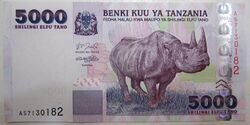Flagship species
Topic: Biology
 From HandWiki - Reading time: 10 min
From HandWiki - Reading time: 10 min

In conservation biology, a flagship species is a species chosen to raise support for biodiversity conservation in a given place or social context. Definitions have varied, but they have tended to focus on the strategic goals and the socio-economic nature of the concept, to support the marketing of a conservation effort. The species need to be popular, to work as symbols or icons, and to stimulate people to provide money or support.
Species selected since the idea was developed in 1980s include widely recognised and charismatic species like the black rhinoceros, the Bengal tiger, and the Asian elephant. Some species such as the Chesapeake blue crab and the Pemba flying fox, the former of which is locally significant to Northern America, have suited a cultural and social context.
Utilizing a flagship species has limitations. It can skew management and conservation priorities, which may conflict. Stakeholders may be negatively affected if the flagship species is lost. The use of a flagship may have limited effect, and the approach may not protect the species from extinction: all of the top ten charismatic groups of animal, including tigers, lions, elephants and giraffes, are endangered.
Definitions

The term flagship is linked to the metaphor of representation. In its popular usage, flagships are viewed as ambassadors or icons for a conservation project or movement. The geographer Maan Barua noted that metaphors influence what people understand and how they act; that mammals are disproportionately chosen; and that biologists need to come to grips with language to improve the public's knowledge of conservation.[1] Several definitions have been advanced for the flagship species concept and for some time there has been confusion even in the academic literature.[2] Most of the latest definitions focus on the strategic, socio-economic, and marketing character of the concept.[2][3] Some definitions are:
- "a species used as the focus of a broader conservation marketing campaign based on its possession of one or more traits that appeal to the target audience"[2]
- "species that have the ability to capture the imagination of the public and induce people to support conservation action and/or to donate funds"[4]
- "popular, charismatic species that serve as symbols and rallying points to stimulate conservation awareness and action"[3][5]
History
The flagship species concept appears to have become popular around the mid 1980s[6] within the debate on how to prioritise species for conservation. The first widely available references to use the flagship concept applied it to both neotropical primates[7] and African elephants and rhinos,[8] in the mammal-centric approach that still dominates how the concept is used.[9][10][11] The use of flagship species has been dominated by large bodied animals,[12] especially mammals,[11] although members of other taxonomic groups have occasionally been used.[13]
File:"Behind the eagel stand the forests" - NARA - 513948.tif
Flagship species projects have sometimes been successful in saving the species and its habitat, as with the American bald eagle[14] and the manatee.[15]
Choosing species
Chosen flagship species include the Bengal tiger (Panthera tigris), the giant panda (Ailuropoda melanoleuca), the Golden lion tamarin (Leontopithecus rosalia), the African elephant (Loxodonta sp.) and Asian elephant (Elephas maximus).[2][9] However, because flagship species are selected according to the audience they are hoping to influence, these species can also belong to traditionally uncharismatic groups, if the cultural and social content is right.[16][2][17] Less charismatic but locally significant species include the use of the Pemba flying fox as a flagship in Tanzania,[16] and of the Chesapeake blue crab as a flagship in the US.[18]
Some flagship species are keystone species, like the African lion, a top predator: it used to control the populations of large herbivores, protecting ecosystems across the entire landscape. However, the lion's ability to serve as a keystone species is decreasing as its population and range decline.[19][20] The WWF uses flagship species as one of its species classification categories, along with keystone and indicator species. It chooses between these when selecting a priority species to represent the conservation threats facing a certain region.[21]

Flagship species can represent an environmental feature (e.g. a species or ecosystem), cause (e.g. climate change or ocean acidification), organization (e.g. NGO or government department) or geographic region (e.g. state or protected area).[2][22][10]
Flagship species can be selected according to many different methodologies, such as social marketing and public awareness,[23][24][25] environmental economics, and conservation biology, depending on what is valued by the audience they try to target,[2] and the goals of the project, such as conservation awareness, fundraising, ecotourism promotion, community-based conservation, and promotion of funded research.[10] This is illustrated by the differences in recommendations made for flagship species selection targeting different target audiences such as local communities[16] and tourists.[12]
Limitations

The use of flagship species has some limitations:[26]
- They can skew the management and conservation priorities in their favour, to the detriment of more threatened but less charismatic species.[27]
- The management of different flagships can conflict.[27]
- The disappearance of the flagship can have negative impacts on the attitudes of the conservation stakeholders.[27]
- They may have limited impact on the behaviour of donors, if the donors cannot dedicate much time to processing the campaign message.[28]
Leaving aside the impact on other species, charisma does not seem to protect even charismatic species against extinction. All ten of the most charismatic groups[lower-alpha 1] of animal identified in a 2018 study, namely tiger, lion, elephant, giraffe, leopard, panda, cheetah, polar bear, wolf, and gorilla, are currently endangered; only the giant panda shows a demographic growth from an extremely small population. The researchers suggest that the widespread use of images of these animals has given the public the impression that the animals are abundant, obscuring their high risk of imminent extinction. They note that this remains true despite the intense focus of conservation efforts on these particular species.[26] A major challenge for the utilization of several flagship species in non-Western contexts is that they may come into conflict with local communities, thereby jeopardizing well-intended conservation actions. This has been termed 'flagship mutiny', and is exemplified by the Asian elephant in countries where there is human-elephant conflict.[9]
Other types
Conservation flagships can be used at broader levels, for example as ecosystems like coral reefs, rainforests or protected areas like the Serengeti or Yellowstone. Some recent initiatives have developed flagships based on the conservation value of particular areas or species. Examples of these are the EDGE project run by the Zoological Society of London and the Hotspots run by Conservation International.[2] More recently, work in microbiology has started to use flagship species in a distinct way. This work relates to the biogeography of micro-organisms and uses particular species because "eyecatching "flagships" with conspicuous size and/or morphology are the best distribution indicators".[29][30]
See also
- Keystone species
- Indicator species
- Charismatic megafauna
- Umbrella species
Notes
- ↑ Elephant includes African savannah, African forest, and Asian species; giraffe has been split into four species.
References
- ↑ Barua, Maan (2011). "Mobilizing metaphors: the popular use of keystone, flagship and umbrella species concepts". Biodiversity and Conservation 20 (7): 1427–1440. doi:10.1007/s10531-011-0035-y. Bibcode: 2011BiCon..20.1427B.
- ↑ 2.0 2.1 2.2 2.3 2.4 2.5 2.6 2.7 Verissimo, Diogo; MacMillan, Douglas C.; Smith, Robert J. (2010-11-29). "Toward a systematic approach for identifying conservation flagships". Conservation Letters 4 (1): 1–8. doi:10.1111/j.1755-263x.2010.00151.x. https://kar.kent.ac.uk/28255/1/VerrissimoetalConLet2011.pdf.
- ↑ 3.0 3.1 Ducarme, Frédéric; Luque, Gloria M.; Courchamp, Franck (2012). "What are "charismatic species" for conservation biologists ?". BioSciences Master Reviews. http://biologie.ens-lyon.fr/ressources/bibliographies/m1-11-12-biosci-reviews-ducarme-f-1c-m.xml. Retrieved 19 December 2013.
- ↑ Walpole, Matthew J.; Leader-Williams, Nigel (2002). "Tourism and Flagship Species in Conservation". Biodiversity and Conservation 11 (3): 543–547. doi:10.1023/a:1014864708777.
- ↑ Heywood, V. H. (1995). Global Biodiversity Assessment. Cambridge University Press. ISBN 978-0521564816.
- ↑ Frazier, J. 2005. Marine turtles: the role of flagship species in interactions between people and the Sea MAST, 3(2) and 4(1),5–38
- ↑ Mittermeier, R. 1988. Primate diversity and the tropical forest. Pages 145-154 in E. O. Wilson, editor. Biodiversity. National Academy Press. Washington, DC.
- ↑ Mittermeier, Russell A. (1986). "Primate Conservation Priorities in the Neotropical Region". in Benirschke, K.. Primates. Proceedings in Life Sciences. Springer New York. pp. 221–240. doi:10.1007/978-1-4612-4918-4_16. ISBN 978-1-4612-9360-6.
- ↑ 9.0 9.1 9.2 Barua, Maan; Tamuly, Jatin; Ahmed, Riyaz Akhtar (2010-03-24). "Mutiny or Clear Sailing? Examining the Role of the Asian Elephant as a Flagship Species". Human Dimensions of Wildlife 15 (2): 145–160. doi:10.1080/10871200903536176. Bibcode: 2010HDW....15..145B.
- ↑ 10.0 10.1 10.2 Barua, Maan; Root-Bernstein, Meredith; Ladle, Richard J.; Jepson, Paul (2011-01-04). "Defining Flagship Uses is Critical for Flagship Selection: A Critique of the IUCN Climate Change Flagship Fleet". Ambio 40 (4): 431–435. doi:10.1007/s13280-010-0116-2. PMID 21809786. Bibcode: 2011Ambio..40..431B.
- ↑ 11.0 11.1 Leader-Williams, N.; Dublin, H. T. (2000). Entwistle, Abigail. ed. Charismatic megafauna as 'flagship species'. Cambridge University Press. pp. 53–81. ISBN 978-0-521-77536-6. OCLC 42682803.
- ↑ 12.0 12.1 Veríssimo, D.; Fraser, I.; Groombridge, J.; Bristol, R.; MacMillan, D. C. (2009-07-03). "Birds as tourism flagship species: a case study of tropical islands". Animal Conservation 12 (6): 549–558. doi:10.1111/j.1469-1795.2009.00282.x. Bibcode: 2009AnCon..12..549V. http://kar.kent.ac.uk/27506/1/Verissimo_etal_2009_Birds_as_flagships.pdf.
- ↑ Guiney, Margaret; Oberhauser, Karen (2009-02-01). "Insects as flagship conservation species". Terrestrial Arthropod Reviews 1 (2): 111–123. doi:10.1163/187498308x414733.
- ↑ "Bald Eagles | Life History and Conservation Success". US Fish & Wildlife Service. 20 April 2015. https://www.fws.gov/midwest/Eagle/recovery/index.html.
- ↑ Carroll, Sean B. (22 April 2016). "How Two Kinds of Regulation Brought Back the Manatee | The massive marine mammal's numbers have increased by 400 percent in the past quarter-century—and it's not the only such success story". Scientific American. https://blogs.scientificamerican.com/guest-blog/how-two-kinds-of-regulation-brought-back-the-manatee/.
- ↑ 16.0 16.1 16.2 Bowen-Jones, Evan; Entwistle, Abigail (2002). "Identifying appropriate flagship species: the importance of culture and local contexts". Oryx 36 (2): 189–195. doi:10.1017/S0030605302000261.
- ↑ Shaw, Meghan N.; Borrie, William T.; McLeod, Emily M.; Miller, Kelly K. (January 2022). "Wildlife Photos on Social Media: A Quantitative Content Analysis of Conservation Organisations' Instagram Images" (in en). Animals 12 (14): 1787. doi:10.3390/ani12141787. ISSN 2076-2615. PMID 35883335.
- ↑ "Save the Crabs – Then Eat 'Em | The NSMC". http://www.thensmc.com/resources/showcase/save-the-crabs.
- ↑ "The African lion: what faster decline of apex predator means for ecosystems". The Conversation. 26 October 2015. http://theconversation.com/the-african-lion-what-faster-decline-of-apex-predator-means-for-ecosystems-49688.
- ↑ Hale, Sarah L.; Koprowski, John L. (February 2018). "Ecosystem-level effects of keystone species reintroduction: a literature review". Restoration Ecology 26 (3): 439–445. doi:10.1111/rec.12684. Bibcode: 2018ResEc..26..439H.
- ↑ "Global Species Programe: how WWF classifies species | Know your flagship, keystone, priority and indicator species". WWF. 2017. http://wwf.panda.org/about_our_earth/species/flagship_keystone_indicator_definition/.
- ↑ Veríssimo, Diogo; MacMillan, Douglas C.; Smith, Robert J. (2011-04-01). "Marketing diversity: a response to Joseph and colleagues". Conservation Letters 4 (4): 326–327. doi:10.1111/j.1755-263x.2011.00175.x. Bibcode: 2011ConL....4..326V.
- ↑ Jarić, Ivan; Crowley, Sarah L.; Veríssimo, Diogo; Jeschke, Jonathan M. (January 2024). "Flagship events and biodiversity conservation". Trends in Ecology & Evolution. doi:10.1016/j.tree.2023.12.002. ISSN 0169-5347. PMID 38233248. https://doi.org/10.1016/j.tree.2023.12.002.
- ↑ Davies, Thomas; Cowley, Andrew; Bennie, Jon; Leyshon, Catherine; Inger, Richard; Carter, Hazel; Robinson, Beth; Duffy, James et al. (2018-09-26). "Popular interest in vertebrates does not reflect extinction risk and is associated with bias in conservation investment" (in en). PLOS ONE 13 (9): e0203694. doi:10.1371/journal.pone.0203694. ISSN 1932-6203. PMID 30256838. Bibcode: 2018PLoSO..1303694D.
- ↑ Holmes, Branden; Strzelecki, Artur; Springer, Steffen; Zieger, Michael (June 2022). "Google Trends data reveal a sharp trend: teeth and claws attract more interest than feathers, hooves or fins" (in en). Environmental Conservation 49 (2): 65–73. doi:10.1017/S037689292200011X. ISSN 0376-8929. Bibcode: 2022EnvCo..49...65H. https://www.cambridge.org/core/product/identifier/S037689292200011X/type/journal_article.
- ↑ 26.0 26.1 Courchamp, F.; Jaric, I.; Albert, C.; Meinard, Y.; Ripple, W. J.; Chapron, G. (April 2018). "The paradoxical extinction of the most charismatic animals". PLOS Biology 16 (4): e2003997. doi:10.1371/journal.pbio.2003997. PMID 29649205.
- ↑ 27.0 27.1 27.2 Simberloff, Daniel (1998). "Flagships, umbrellas, and keystones: Is single-species management passé in the landscape era?". Biological Conservation 83 (3): 247–257. doi:10.1016/s0006-3207(97)00081-5. Bibcode: 1998BCons..83..247S.
- ↑ Veríssimo, Diogo; Campbell, Hamish A.; Tollington, Simon; MacMillan, Douglas C.; Smith, Robert J. (2018-01-25). "Why do people donate to conservation? Insights from a 'real world' campaign". PLOS ONE 13 (1): e0191888. doi:10.1371/journal.pone.0191888. PMID 29370291. Bibcode: 2018PLoSO..1391888V.
- ↑ Foissner, Wilhelm (April 2005). "Two new "flagship" ciliates (Protozoa, Ciliophora) from Venezuela: Sleighophrys pustulata and Luporinophrys micelae". European Journal of Protistology 41 (2): 99–117. doi:10.1016/j.ejop.2004.10.002.
- ↑ Foissner, W.; Stoeck, T. (2006). "Rigidothrix goiseri nov gen., nov spec. (Rigidotrichidae nov fam.), a new "flagship" ciliate from the Niger floodplain breaks the flexibility-dogma in the classification of stichotrichine spirotrichs (Ciliophora, Spirotrichea)". European Journal of Protistology 42 (4): 249–267. doi:10.1016/j.ejop.2006.07.003. PMID 17113471.
Further reading
- Caro, Tim (2010). Conservation by proxy: indicator, umbrella, keystone, flagship, and other surrogate species. Washington, DC: Island Press. ISBN 9781597261920.
- Home, R.; Keller, C.; Nagel, P.; Bauer, N.; Hunziker, M. (2009). "Selection criteria for flagship species by conservation organizations". Environmental Conservation 36 (2): 139–148. doi:10.1017/s0376892909990051. Bibcode: 2009EnvCo..36..139H. http://doc.rero.ch/record/298772/files/S0376892909990051.pdf.
- Smith, R. J.; Veríssimo, D.; Isaac, N. J. B.; Jones, K. E. (2012). "Identifying Cinderella species: uncovering mammals with conservation flagship appeal". Conservation Letters 5 (3): 205–212. doi:10.1111/j.1755-263x.2012.00229.x. Bibcode: 2012ConL....5..205S. http://www.diogoverissimo.com/wp-content/uploads/2012/04/Identifying-Cinderella-species-uncovering-mammals-with-conservation-flagship-appeal.pdf.
- Takahashi, Y.; Veríssimo, D.; MacMillan, D. C.; Godbole, A. (2012). "Stakeholder Perceptions of Potential Flagship Species for the Sacred Groves of the North Western Ghats, India". Human Dimensions of Wildlife 17 (4): 257–269. doi:10.1080/10871209.2012.675622. Bibcode: 2012HDW....17..257T. http://www.diogoverissimo.com/wp-content/uploads/2012/08/Stakeholder-Perceptions-of-Potential-Flagship-Species-for-the-Sacred-Groves-of-the-North-Western-Ghats-India.pdf.
- Veríssimo, D.; Barua, M.; Jepson, P.; MacMillan, D. C.; Smith, R. J. (2012). "Selecting marine invertebrate flagship species: Widening the net". Biological Conservation 145 (1): 4. doi:10.1016/j.biocon.2011.11.007. Bibcode: 2012BCons.145....4V. http://www.diogoverissimo.com/wp-content/uploads/2012/02/Selecting-marine-invertebrate-flagship-species-Widening-the-net.pd.
- Veríssimo, D.; Jones, D. A.; Chaverri, R.; Meyer, S. R. (2012). "Jaguar Panthera onca predation of marine turtles: conflict between flagship species in Tortuguero, Costa Rica". Oryx 46 (3): 340–347. doi:10.1017/s0030605311001487. http://www.diogoverissimo.com/wp-content/uploads/2012/04/Jaguar-Panthera-onca-predation-of-marine-turtles-conflict-between-flagship-species-in-Tortuguero-Costa-Rica.pdf.
 |
 KSF
KSF